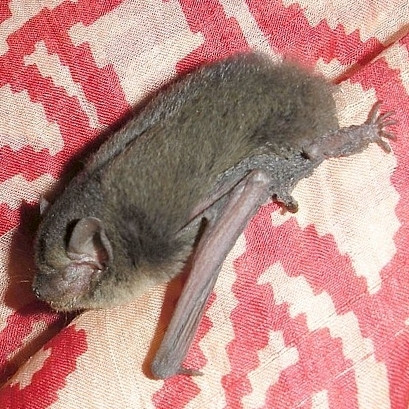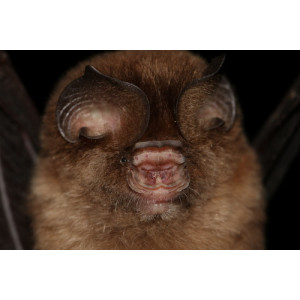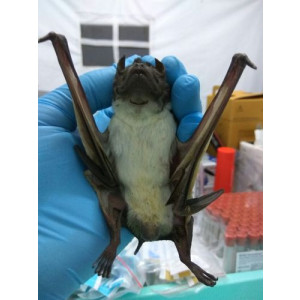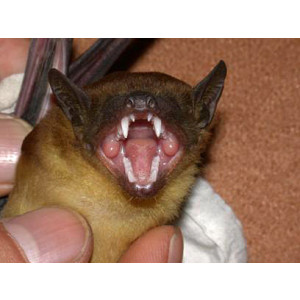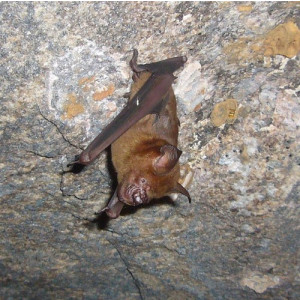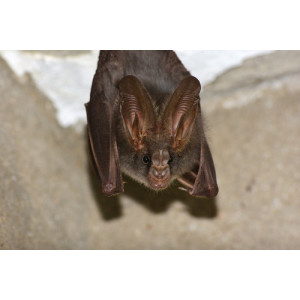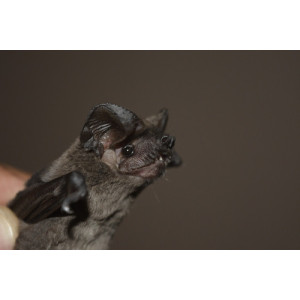Indian Pipistrelle Did you see this animal?
Scientific Name : Pipistrellus coromandra
Family : Vespertilionidae
Order : Chiroptera
Class : Mammalia
Phylum : Chordata
Other Name : Little Indian Bat, Coromandel Pipistrelle.
Habitat : Forest, Caves and Subterranean Habitats (non-aquatic)
Description : The Little Indian Bat is one of the smallest bat species in the world, measuring only 3 to 5 centimeters in length and weighing about 3 to 5 grams. It has a brown or grayish-brown fur coat with a paler underside, and large, pointed ears.
The Little Indian Bat is an insectivorous bat, feeding on a variety of insects such as moths, flies, and mosquitoes. They use echolocation to locate their prey, emitting high-frequency sound waves and listening for the echoes that bounce back.
These bats are found in a wide range of habitats, including forests, agricultural fields, and urban areas. They roost in small colonies in crevices of buildings, caves, and trees.
The Little Indian Bat is a nocturnal animal, meaning it is active at night. They emerge from their roosts at dusk and fly in search of food. During the day, they rest in their roosts. They are social animals and often roost in large colonies.
The Little Indian Bat has a breeding season that lasts from April to August. Females give birth to one or two offspring each year. The young are born with their eyes closed and are completely dependent on their mothers for the first few weeks of life.
The Little Indian Bat is not currently considered threatened, but it is facing several threats, including habitat loss and degradation, disturbance of roosts, and indiscriminate use of pesticides. Conservation efforts are needed to ensure their survival.
In summary, the Little Indian Bat is a small, insectivorous bat found in the Indian subcontinent. It has a brown or grayish-brown fur coat, feeds on insects, roosts in small colonies, and is active at night. Conservation efforts are needed to protect this species from threats such as habitat loss and degradation.
The Little Indian Bat is an insectivorous bat, feeding on a variety of insects such as moths, flies, and mosquitoes. They use echolocation to locate their prey, emitting high-frequency sound waves and listening for the echoes that bounce back.
These bats are found in a wide range of habitats, including forests, agricultural fields, and urban areas. They roost in small colonies in crevices of buildings, caves, and trees.
The Little Indian Bat is a nocturnal animal, meaning it is active at night. They emerge from their roosts at dusk and fly in search of food. During the day, they rest in their roosts. They are social animals and often roost in large colonies.
The Little Indian Bat has a breeding season that lasts from April to August. Females give birth to one or two offspring each year. The young are born with their eyes closed and are completely dependent on their mothers for the first few weeks of life.
The Little Indian Bat is not currently considered threatened, but it is facing several threats, including habitat loss and degradation, disturbance of roosts, and indiscriminate use of pesticides. Conservation efforts are needed to ensure their survival.
In summary, the Little Indian Bat is a small, insectivorous bat found in the Indian subcontinent. It has a brown or grayish-brown fur coat, feeds on insects, roosts in small colonies, and is active at night. Conservation efforts are needed to protect this species from threats such as habitat loss and degradation.
Distribution in Bangladesh
References:
description written by: Asad U. Tanvir, Department of Zoology, Jagannath University, Dhaka; reviewed by: Muntasir Akash, Department of Zoology, University of Dhaka; Taxonomic Checklist: Red List of Bangladesh Volume 2: Mammals, 2015, IUCN; information sources: Khan 2018 (Photographic guide to the wildlife of Bangladesh), www.thainationalparks.com, photo credit: Samiul Mohsanin, (Jahangirnagar University, Dhaka), photo copyright: Samiul Mohsanin. For more information, please contact with us.
description written by: Asad U. Tanvir, Department of Zoology, Jagannath University, Dhaka; reviewed by: Muntasir Akash, Department of Zoology, University of Dhaka; Taxonomic Checklist: Red List of Bangladesh Volume 2: Mammals, 2015, IUCN; information sources: Khan 2018 (Photographic guide to the wildlife of Bangladesh), www.thainationalparks.com, photo credit: Samiul Mohsanin, (Jahangirnagar University, Dhaka), photo copyright: Samiul Mohsanin. For more information, please contact with us.
